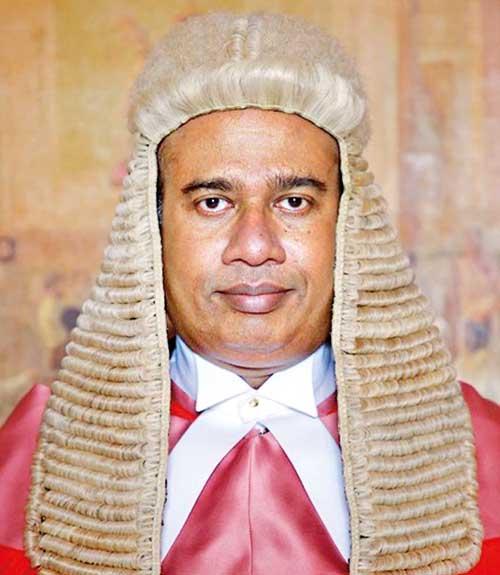Reply To:
Name - Reply Comment
- Number of judges per million is 15
- Fund allocation to justice sector less than 1% during 2010-2019
- 50% of serving HC judges, who bag over 25 years of experience, will retire by 2025 without being elevated to the Court of Appeal and SC owing to inadequate vacancies
Addressing the ceremonial welcome in both Sinhala and English languages, newly-appointed Supreme Court Justice Yasantha Kodagoda PC said there was a compelling need to  increase the number of judges in all courts along with the allocation of necessary resources to the justice sector as the insufficiency of judges and resources could result in delays in the administration of justice.
increase the number of judges in all courts along with the allocation of necessary resources to the justice sector as the insufficiency of judges and resources could result in delays in the administration of justice.
While underscoring that the allocation of public funds to the justice sector from 2010 to 2019 never exceeded 1% of the total annual expenditure of the State, he said nearly 50% of serving High Court judges, who bagged over 25 years of judicial experience, would retire by 2025 without being elevated to the Court of Appeal and Supreme Court owing to
inadequate vacancies.
According to the Constitution, the Supreme Court shall comprise the Chief Justice along with not less than six and not more than ten other judges. The Court of Appeal consists of its President along with not less than six and not more than eleven other Judges. Excerpts from his speech:
I think it is necessary to consider if Sri Lanka had a sufficient number of judges to administer justice expeditiously. This is vital because insufficiency of judges will lead to delays in the administration of justice.
Globally, the unit of measurement is the number of judges in a particular country per million population. The US has 107 judges per million population. Canada has 75, England 51 and neighbouring India 20 per million population.
Sri Lanka has a total of 336 judges and magistrates including justices of Court of Appeal and Supreme Court. Thus, in Sri Lanka, the number of judges per million is 15. I assume the judge-population ratio speaks for itself and does not require any elaboration by me on its causal relationship with existing delays in the administration of justice.
The cadre of judges in the Supreme Court and Court of Appeal had been determined in 1978 -- at a time when Sri Lanka’s population stood at 14.5 million. The cadre of judges in these two courts has remained static, notwithstanding the population of our country soaring to 21.5 million. This situation is compounded by the increase in the workload of these two courts.
The fundamental rights jurisdiction of the Supreme Court will attract some 500 fresh applications and there will be over 500 applications from judgments of the High Courts in provinces functioning as Civil Appellate High Courts. This is in addition to the routine workload of the Supreme Court.
"The cadre of judges in the Supreme Court and Court of Appeal had been determined in 1978 -- at a time when Sri Lanka’s population stood at 14.5 million. The cadre of judges in these two courts has remained static, notwithstanding the population of our country soaring to 21.5 million"
The workload of the Court of Appeal is equally heavy. In 2019, the Court of Appeal received some 1,500 fresh appeals and applications including 525 writs.
The prevailing situation in connection with the cadre of judges in the Supreme Court and the Court of Appeal should, in my view, be considered from another perspective. Of the 79 judges in the High Court presently serving the republic, unless elevated to the Court of Appeal, 14 judges are to retire in the coming three years when they reach the retirement age of 61.
 A total of 36 judges in the High Court are to retire by 2025. That would be 50% of the present number of judges in the High Court. These are judicial officers who have nearly 25 years of judicial experience and who have served the country with utmost dedication. It is unfortunate that the Supreme Court and the Court of Appeal will not receive the benefit of their judicial skills and experience. The position of senior officers in the Attorney General’s Department is similar too.
A total of 36 judges in the High Court are to retire by 2025. That would be 50% of the present number of judges in the High Court. These are judicial officers who have nearly 25 years of judicial experience and who have served the country with utmost dedication. It is unfortunate that the Supreme Court and the Court of Appeal will not receive the benefit of their judicial skills and experience. The position of senior officers in the Attorney General’s Department is similar too.
Thus, I would respectfully express that there exists a compelling need to assess and determine afresh the cadre of judges in all courts. Should the number of judges be increased along with a proportionate increase in the cadres of non-judicial staff in courts, and the allocation of necessary logistical resources to the justice sector, the efficiency and productivity of the administration of the justice system will increase in a tangible manner.
This will result in the expeditious passage of cases through the court system. Therefore, I urge relevant authorities to give serious and responsive consideration to the compelling need of increasing the cadre of judges in the Supreme Court and the Court of Appeal.
The procurement of necessary resources including courthouses and associated paraphernalia is conditioned upon the availability of financial resources. An examination of provisions and schedules of the Appropriation Acts of the last decade illustrates a startling revelation.
During 2010 and 2019, the allocation of public funds to the justice sector has never exceeded 1% of total annual expenditure of the State. This 1% or less has been for both capital and recurrent expenditure of the entire sector.
This is the nature of financial investment by the State to the justice sector. I assume you would form your own views regarding the sufficiency of such money to run an efficient system.
I would respectfully say that the scarcity of necessary financial resources exemplifies the standard of our courthouses, conditions of chambers and quarters of judges, virtual absence of automation and application of technological tools, and the paucity of other necessary human/material resources that should be available to the justice sector.
Unless there is a significant increase in the allocation of funds from the consolidated fund to run the third organ of the State (the justice sector), improving the system and making it efficient would be a virtual impossibility.